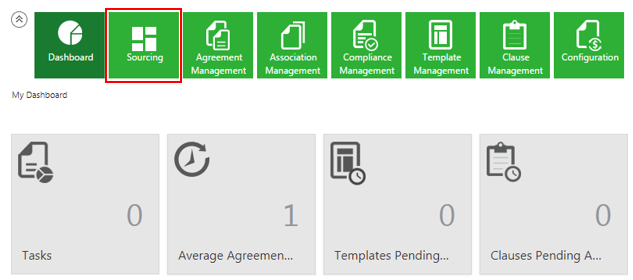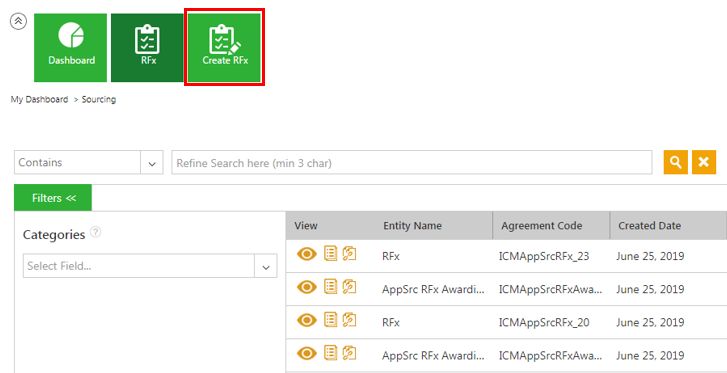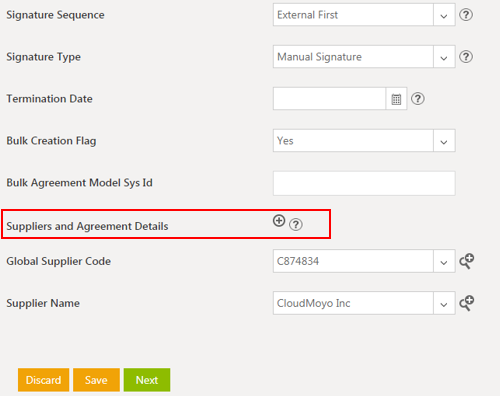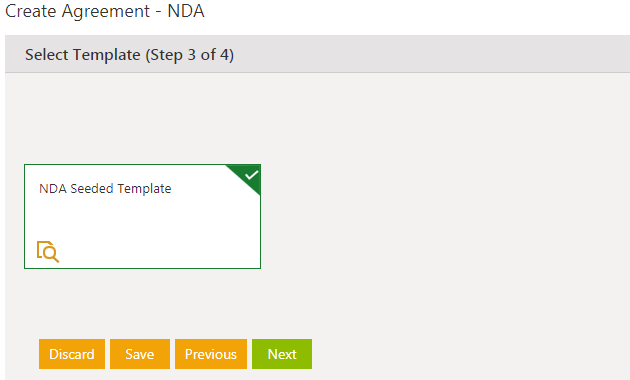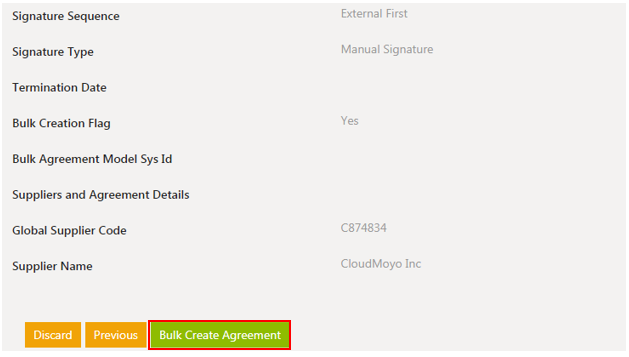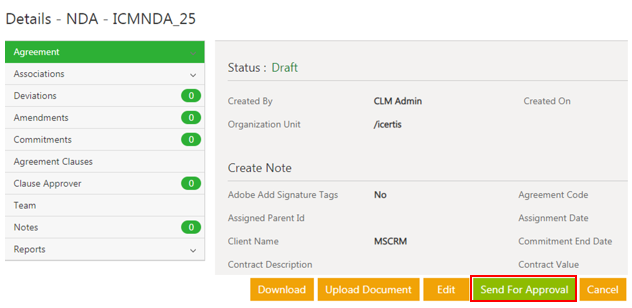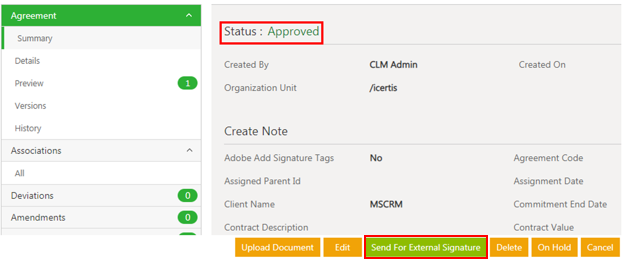| Line 89: | Line 89: | ||
6. '''Click''' ''Save''. The selected questionnaire and question (s) are added to the RFI instance. The count is updated under the ''RFI Package'' tab. | 6. '''Click''' ''Save''. The selected questionnaire and question (s) are added to the RFI instance. The count is updated under the ''RFI Package'' tab. | ||
| − | + | ||
| + | == Creating Bulk Agreements == | ||
The Sourcing App offers you a convenient way of creating bulk agreements with the suppliers, without having to move out of RFx instance that you are working on. The agreements must be already configured in ICM. These agreements may be made mandatory for the supplier to sign before the supplier can participate in the RFx. The RFx displays all the agreements created from the RFx and they have all the agreement information. This allows the buyer to conveniently navigate between the RFx and the agreement associated with the RFx. | The Sourcing App offers you a convenient way of creating bulk agreements with the suppliers, without having to move out of RFx instance that you are working on. The agreements must be already configured in ICM. These agreements may be made mandatory for the supplier to sign before the supplier can participate in the RFx. The RFx displays all the agreements created from the RFx and they have all the agreement information. This allows the buyer to conveniently navigate between the RFx and the agreement associated with the RFx. | ||
| Line 118: | Line 119: | ||
<div class="image-green-border">[[File:7.9 Sourcing Creating Bulk Agreements 10.png|720px|7.9 Sourcing Creating Bulk Agreements 10.png]]</div> | <div class="image-green-border">[[File:7.9 Sourcing Creating Bulk Agreements 10.png|720px|7.9 Sourcing Creating Bulk Agreements 10.png]]</div> | ||
11. '''Click''' the ''Send For External Signature'' button on the ''Details'' page. The agreement is sent to the supplier(s) for signatures. The status of the agreement changes to ''Executed'' when all the suppliers sign the NDA. | 11. '''Click''' the ''Send For External Signature'' button on the ''Details'' page. The agreement is sent to the supplier(s) for signatures. The status of the agreement changes to ''Executed'' when all the suppliers sign the NDA. | ||
| − | <div class="image-green-border">[[File:7.9 Sourcing Creating Bulk Agreements 11.png|720px|7.9 Sourcing Creating Bulk Agreements 11.png]]</div> | + | <div class="image-green-border">''[[File:7.9 Sourcing Creating Bulk Agreements 11.png|720px|7.9 Sourcing Creating Bulk Agreements 11.png]]''</div> <div class="image-green-border"> </div> |
| + | == Adding Team members in RFI == | ||
| + | |||
| + | A team of Approvers, Reviewers, and Observers can be added to the RFI instance for completing the workflow. | ||
| + | |||
| + | To add team members: | ||
| + | |||
| + | 1. '''Click''' the ''Team'' tab on the RFI ''Details'' page. The ''Add Team'' page opens in the right pane. | ||
| + | |||
| + | 2. '''Click''' the ''Add Team'' icon. The ''Select User'' window opens. <br/> 3. '''Enter''' the search term in the ''Search User'' field to search for a desired user. | ||
| + | |||
| + | 4. '''Select''' a User from the displayed user tiles.<br/> 5. '''Select''' a Role. For example, Approver, Business Owner, Observer, etc. <br/> 6. '''Select''' or enter the Step Number if you select Approver in the Select Role field.<br/> 7. '''Enter''' a comment in the Add Note field (optional). You can see this comment under the Notes tab.<br/> 8. '''Select''' the ''Send Notification'' checkbox if you want to the user to receive a notification of the task.<br/> 9. '''Click''' ''Add''. The ''User has been added successfully'' message is displayed.<br/> | ||
Revision as of 12:03, 23 December 2019
Contents
Working with RFI instances
A Request for Information (RFI) is a set of questions shared with potential suppliers to assess their ability to fulfil certain requirements to provide goods or services. The purpose of an RFI is to solicit information from potential suppliers for buying goods or services. This is done in the form of a questionnaire with specific and general answers. The information provided by prospective suppliers are used for judging their technical capabilities, financial stability, cultural compatibility and suitability for the buying requirements of the organization. It is recommended to have specific qualification criteria for prospective supplier to compete for a business requirement of the buyer. For example, Company size in terms of revenue, technical certifications, locations and so on. An RFI does not solicit any specific proposal for any purchase or pricing information. The outcome of an RFI is a rating given to the supplier based on qualification criteria set by the buyer and not awarding of business.
Creating the RFI instances
1. Click the Sourcing tile on the Dashboard. The Sourcing page opens. A list of all the RFx instances is displayed.
2. Click the Create RFx tile. The Create RFx page opens.
3. Select a Sourcing Entity from the Select Sourcing Entity drop-down in the Contract Type Details (Step 1 of 4) section. The contract type is configured in the system with default Attributes.
4. Click Next. The Attributes (Step 2 of 4) page opens. The attributes are grouped under various categories. For example, RFI Information, RFI Configuration, etc.
5. Select or enter the values for all the required Attributes in the RFI Information group:
- Enter the RFI Name. For example, Laptop Supplier Information.
- Enter the information of the RFI instance in the Description field.
- Select the Round One Start Date and Round One End Date. When you enter the dates, a round is created automatically as soon as the RFI instance is approved. If the round start and end dates are not provided, the round will not be created for the RFI instance.
6. Select appropriate values and settings under the RFI Configuration group.
- Select Yes or No for the following Configuration settings as per your requirement:
- Allow Foreclosure of Rounds: Select Yes if you want to allow closing the round before the selected round end date. This displays the Close Round button on the Round Details page to close the round manually before scheduled Round end date and time.If you select No, then the round will be closed automatically at the selected round end date and time. The default value for this option is set to Yes.
- Copy Questions and Supplier Responses from previous Round: Select Yes if you want to allow copying questions and supplier responses from previous rounds to the new round. The default value for this option is set to Yes.
- Allow new supplier during RFI phase: Select Yes if you want to allow adding a new supplier(s) during the entire RFI lifecycle. However, the newly added supplier(s) can participate in a new round only, not in an ongoing round. The default value for this option is set to Yes.
- Allow new question during RFI phase: Select Yes if you want to allow adding a new question during the RFI lifecycle. However the newly added question (s) can be part of the round only before it starts and not in an ongoing round. The default value for this option is set to Yes.
- Enter the Terms For Participation in the given field. This window will be visible to the suppliers only if the buyer adds the terms for participation when creating the RFI. The suppliers should accept the Terms before they can respond to the questions asked by the buyer. The Supplier can access the RFI instance only after it is in Approved state. After the Round is started, a Terms for Participation window is displayed to the supplier with an option to accept or decline. For example, if a supplier has multiple contacts and if one of the contacts accepts the terms for participation, then other contacts are not required to take any action on that and the Terms for Participation will not be displayed to the remaining contacts.
- Select the following contracts (if applicable) by clicking the drop-down arrow or the Lookup Search icon:
- Associate Contracts: Sourcing app allows the buyers to create contracts such as NDA, for all the suppliers selected when creating RFI. A separate contract will be created for each supplier.
- Mandatory Contracts: The value in this option will be populated automatically based on the value selected in the earlier option. You cannot select any value in this option if you don’t select anything in the Associate Contracts option.
- Prerequisite Contracts: The Supplier can access the RFI instance only after it is in Approved state. After the Round is started, a Terms for Participation window is displayed to the supplier with an option to accept or decline. The Suppliers can access the RFI only after they sign the Prerequisite Contract after accepting the terms for participation. If the Suppliers do not sign the contracts a message is displayed by ICM, along with a list of documents asking the suppliers to complete the documents before accessing the RFI.The values selected in these fields are populated on the RFI Details page under the Agreements tab.
The values selected in these fields are populated on the RFI Details page under Agreements tab.
Note: Selecting an Associate Contract automatically populates the values in Mandatory Contracts and Prerequisite Contracts. If you do not select any values in any of the contracts, these values will be displayed as blank when you create the RFI. This will not allow you to create Bulk Agreements.
RFI Details page
Buyers can view the current status and details of the RFI. Buyers can also perform a variety of actions based on the current state of the RFI.
Here is a brief description of the options in the left navigation pane of RFI Details page.
- RFI Information: This section displays the basic details of the current RFI instance. It has the following sub-sections.
- Summary: Displays the name of the RFI instance (that is added while creating) and who created it, and RFI instance details.
- Details: Displays the details specified while creating the RFI instance.
- Preview: Displays how the RFI document would actually look. Click the click here in To see full document click here to download and view the full document in pdf format.
- RFI Package: This section displays the following details.
- Questionnaire: Click this option to view the list of questionnaires associated with the RFI. Click the plus icon next to Questionnaire on RFI Details page to add a new questionnaire. You can select or remove questionnaire from the available list of questionnaires. It is mandatory to add a questionnaire along with questions to the RFI before sending the RFI for approval.
- Question: Click this option to view the list of questions associated with the questionnaire and RFI.
- Internal Attachments: Displays the list of existing internal attachments associated with the RFI. Internal attachments are associated documents uploaded by the buyers and only available to the buyer team. Click the plus icon next to internal attachments to add new to the list.
- External Attachments: Displays the list of existing external attachments associated with the RFI. External attachments are associated documents uploaded by the buyers and available to both buyers and suppliers. Click the plus icon next to external attachments to add new to the list. For example, the bulk agreements such as NDA and Warranty agreements are displayed under this section.
- Supplier Information: Displays the list of existing suppliers and allows buyers to add new suppliers along with their contact information.
- Suppliers: Displays the list of suppliers added to the RFI created by the buyer. Click the plus icon next to Suppliers to add a new supplier.
- Supplier Contacts: Displays the list of relevant supplier contacts that are populated automatically after you select the suppliers in the previous step.
- Agreements: Displays all the agreements that were selected initially when creating the RFI.
- Collaboration: Allows the internal or external team members to communicate with other internal or external team members by creating topics and posting messages in it.
- Round: Displays the list of rounds (automatic and manual) associated with the RFI along with their current state. Click the plus icon next to Round to add a new round.
- Team: Displays the members added to the team for this RFI instance. Click the plus icon to add new team members to the RFI.
- Notes: Displays the additional information about the RFI if it is added.
- History: Displays how the RFI has progressed till now. The actions performed by the buyer are displayed by the buyer and supplier on the RFI instance are displayed under History in the left navigation pane on RFI Details page.
Buyers can perform the following actions from the RFI Details page:
- Download RFI Document: Click this button to download the RFI document in Microsoft Word format. The downloaded document is based on the template selected while creating the RFI instance.
- Edit: Click this button to go back and make changes to the RFI that you created.
- Send for Approval: Click this button to send the RFI instance for approval.
- Download Package: Click this button to download the RFI instance along with all its associations. You can select specific associations that you want to download or select the RFI instance checkbox to download the RFI package. RFI package is downloaded as a zip file that contains all the attachments relevant to the RFI. When the zip file is exported on user’s local machine, a folder structure is created that resembles the RFI structure, and the files are located in the respective locations.
- Delete: Click this button to delete the RFI instance. After deleting the RFI instance, the Sourcing page opens and the deleted RFI will not be available on the user interface.
Adding Questionnaires
You can add questionnaires at any stage of the RFI instance depending upon RFI configuration settings. Questionnaires are a set of questions that the buyer shares with potential suppliers who can fulfil the requirement of providing goods or services to the buyers. When you create the RFI instance, the RFI Details page opens with the RFI status displayed as Draft. You can use the left navigation pane to add one or more questionnaires.
To add questionnaires:
1. Click the plus button next to Questionnaire under the RFI Package tab. The Questionnaires window opens.
2. Search for the desired questionnaire (s) or select the questionnaire from the displayed list under the Questionnaires tab.
3. Click Next. The Questions tab opens displaying the list of questions associated with the questionnaire.
4. Click the View Record icon next to the Question to view the question information.
5. Select the desired question.
6. Click Save. The selected questionnaire and question (s) are added to the RFI instance. The count is updated under the RFI Package tab.
Creating Bulk Agreements
The Sourcing App offers you a convenient way of creating bulk agreements with the suppliers, without having to move out of RFx instance that you are working on. The agreements must be already configured in ICM. These agreements may be made mandatory for the supplier to sign before the supplier can participate in the RFx. The RFx displays all the agreements created from the RFx and they have all the agreement information. This allows the buyer to conveniently navigate between the RFx and the agreement associated with the RFx.
To create an agreement:
1. Click the Create Association icon next to the agreements in the left navigation pane on the RFx Details page. For example, NDA, Warranty Agreement.
2. The Attributes (Step 2 of 4) page opens in the new browser tab.
3. Enter values for all the attributes, some of which may be mandatory.
4. Click the Select Multiple Suppliers icon next to Suppliers and Agreement Details. The Supplier page opens.
5. Repeat steps 2 to 6 from the Selecting Suppliers section to add a supplier.
6. Click Next. The Select Template (Step 3 of 4) page opens.
7. Select a Template.
8. Click Next. The Verify page opens. Verify all the information you have entered.
9. Click the Bulk Create Agreement button. The agreement is created.
10. Click the View Record icon next to the NDA instance on the Sourcing page. The NDA’s Details page opens with the NDA in the Draft state.
After the Agreement is created for a supplier, you can proceed with the agreement workflow as configured. For example, you can send the agreement for approval.
11. Click the Send For External Signature button on the Details page. The agreement is sent to the supplier(s) for signatures. The status of the agreement changes to Executed when all the suppliers sign the NDA.
Adding Team members in RFI
A team of Approvers, Reviewers, and Observers can be added to the RFI instance for completing the workflow.
To add team members:
1. Click the Team tab on the RFI Details page. The Add Team page opens in the right pane.
2. Click the Add Team icon. The Select User window opens.
3. Enter the search term in the Search User field to search for a desired user.
4. Select a User from the displayed user tiles.
5. Select a Role. For example, Approver, Business Owner, Observer, etc.
6. Select or enter the Step Number if you select Approver in the Select Role field.
7. Enter a comment in the Add Note field (optional). You can see this comment under the Notes tab.
8. Select the Send Notification checkbox if you want to the user to receive a notification of the task.
9. Click Add. The User has been added successfully message is displayed.
